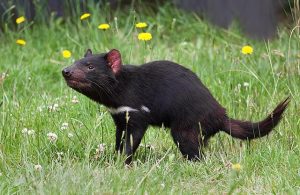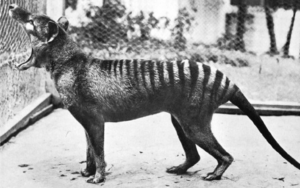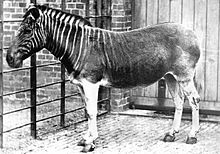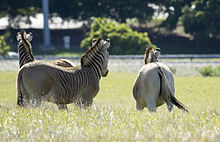Podcast: Play in new window | Download (Duration: 9:48 — 10.9MB)
Thanks to Carson, Mia, Eli, and Pranav for their suggestions this week!
Further reading:
RNA for the first time recovered from an extinct species
Study finds ongoing evolution in Tasmanian Devils’ response to transmissible cancer
Tasmanian devil research offers new insights for tackling cancer in humans
The Tasmanian devil looks really cute but fights all the time [picture by JJ Harrison (https://www.jjharrison.com.au/) – Own work, CC BY-SA 3.0]:

The Thylacine could opens its jaws verrrrrrry wide:

Show transcript:
Welcome to Strange Animals Podcast. I’m your host, Kate Shaw.
This week we’re going to cover two animals that a lot of people have suggested. Carson and Mia both want to learn about the Tasmanian tiger, and Eli and Pranav both want to hear about the Tasmanian devil. We talked about the Tasmanian tiger, AKA the thylacine, in episode 1, and I thought we’d had a Tasmanian devil episode too but it turns out I was thinking of a March 2019 Patreon bonus episode. So it’s definitely time to learn about both!
The thylacine was a nocturnal marsupial native to New Guinea, mainland Australia, and the Australian island of Tasmania, and the last known individual died in captivity in 1936. But thylacine sightings have continued ever since it was declared extinct. It was a shy, nervous animal that didn’t do well in captivity, so if the animal survives in remote areas of Tasmania, it’s obviously keeping a low profile.
The thylacine was yellowish-brown with black stripes on the back half of its body and down its tail. It was the size of a big dog, some two feet high at the shoulder, or 61 cm, and over six feet long if you included the long tail, or 1.8 meters. It had a doglike head with rounded ears and could open its long jaws extremely wide. Some accounts say that it would sometimes hop instead of run when it needed to move faster, but this seems to be a myth. It was also a quiet animal, rarely making noise except while hunting, when it would give frequent double yips.
A 2017 study discovered that the thylacine population split into two around 25,000 years ago, with the two groups living in eastern and western Australia. Around 4,000 years ago, climate change caused more and longer droughts in eastern Australia and the thylacine population there went extinct. By 3,000 years ago, all the mainland thylacines had gone extinct, leaving just the Tasmanian population. The Tasmanian thylacines underwent a population crash around the same time that the mainland Australia populations went extinct—but the Tasmanian population had recovered and was actually increasing when Europeans showed up and started shooting them.
Because the thylacine went extinct so recently and scientists have access to preserved specimens less than a hundred years old, and since the thylacine’s former habitat is still in place, it’s a good candidate for de-extinction. As a result, it’s been the subject of many genetic studies recently, to learn as much about it as possible. It’ll probably be quite a while before we have the technology to successfully clone a thylacine, but in the meantime people in Australia keep claiming to see thylacines in the wild. Maybe they really aren’t extinct.
The Tasmanian devil is related to the thylacine. It’s about the size of a small to average dog, maybe a bulldog, which it resembles in some ways. It’s compact and muscular with a broad head, relatively short snout, and a big mouth with prominent lower fangs. It’s not related to canids at all, of course, and if you just glanced at a Tasmanian devil, your first thought wouldn’t be “dog” or “thylacine,” it would probably be “giant mouse.”
The Tasmanian devil is black or grayish-brown, usually with patches of white on the chest and rump. It also has rounded pinkish ears, long whiskers, paws with relatively long toes, and a long tail. Since the devil stores fat in its tail, a fat-tailed devil is a happy, healthy devil.
It’s mainly a scavenger and will eat roadkill and other dead animals, although it will also kill and eat small or even large animals, and will also eat plant material and insects. It often eats every trace of a carcass, including bones and fur. This is good for other animals and for ranchers, since it reduces the presence of insects attracted to dead animals and reduces the spread of disease. Its digestion is extremely fast and efficient, and its jaws are extremely strong.
The Tasmanian devil is usually solitary, but it does get together with other devils to socialize and fight while eating. When a devil finds a carcass, it will make extremely loud calls to alert other devils to come share its meal. Then, because they’re called devils and not angels for a reason, the animals will fight over the food.
Tasmanian devils fight a lot. Researchers think the white markings help direct other devils to attack parts of the body that are less vulnerable to injury. The white fur is more visible in the dark, giving other devils a target. The white markings are usually on the devil’s chest, sides, and rump, with none on the face or legs. Males fight each other during breeding season, and the females pick the winners to mate with. If a female doesn’t like a male, she’ll fight him.
Devils are marsupials, which means babies are born very early and finish developing in their mother’s pouch. The Tasmanian devil’s pouch is rear-facing and contains four teats. The problem is, the mother has 20 or even 30 babies at a time. They’re born about the size of a jellybean and the only part that’s developed at that point is the forelegs so it can crawl into the mother’s pouch. The legs have claws and—you guessed it—the little squidge babies fight for a teat. Once one gets to a teat, it clamps on and doesn’t let go for the next three months. Babies that don’t get a teat die.
Like the thylacine, the Tasmanian devil once lived on mainland Australia but is now restricted to the island of Tasmania. Also like the thylacine, it shows low genetic diversity and was once killed for bounty by early settlers. It’s affected by habitat loss like many other animals, and it’s especially vulnerable to being run over by cars because it eats so much roadkill.
But the devil’s biggest issue today is a disease called devil facial tumor disease, or DFTD. DFTD is spread when an infected animal bites another one, which causes cancerous growths in and around the mouth. After a few months the tumors get so big that the devil can no longer eat and starves to death. Since devils bite each other all the time, the disease spreads quickly throughout a population.
In 2019 some researchers predicted the Tasmanian devil would be extinct by 2024. But here it is 2024 and not only is the devil not extinct, it’s actually doing a lot better now than it was just a few years ago.
Part of that is due to conservation efforts, where healthy devils are quarantined from infected ones in captive breeding programs. But part of it is natural. In 2018 a small population of devils was discovered that appeared to have developed a natural resistance to DFTD. Genetic studies done since then revealed some surprises. Not only are younger devils showing a genetic resistance to DFTD, there’s evidence that resistance to other transmissible cancers has developed in the past. Researchers think the Tasmanian devil might be especially prone to transmissible cancers but is also able to develop resistance relatively quickly. The devils with this resistance start growing tumors, but then the tumors stop growing and soon just disappear. Naturally, scientists are looking at the genetics of this trait to see if it can be applied to humans with certain types of cancer.
While Tasmanian devils fight each other, they don’t actually fight humans. Scientists report that it’s actually quite easy to work with. This makes it a lot easier to check the health of a captured animal. Hopefully it won’t be long before the entire population of Tasmanian devils is healthy and its numbers start to increase again.
You can find Strange Animals Podcast at strangeanimalspodcast.blubrry.net. That’s blueberry without any E’s. If you have questions, comments, or suggestions for future episodes, email us at strangeanimalspodcast@gmail.com. We also have a Patreon at patreon.com/strangeanimalspodcast if you’d like to support us for as little as one dollar a month and get monthly bonus episodes.
Thanks for listening!

